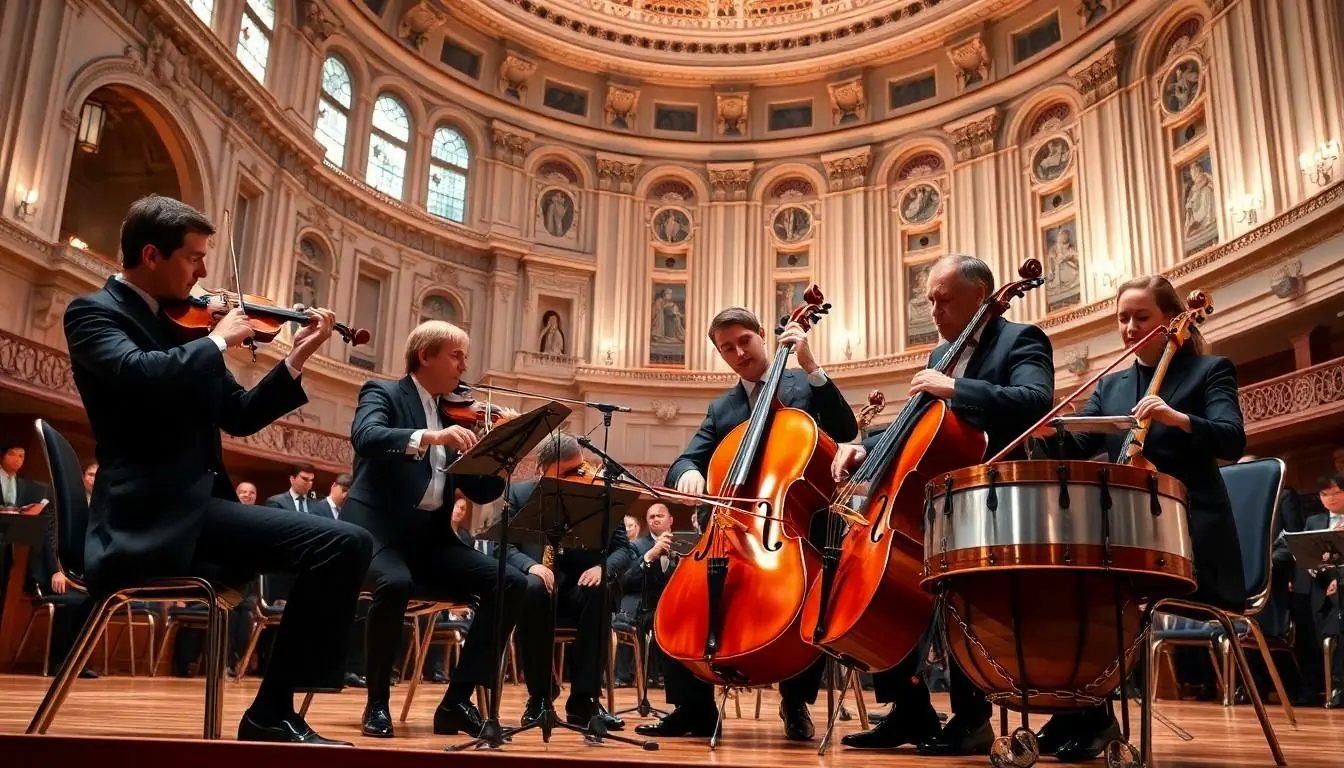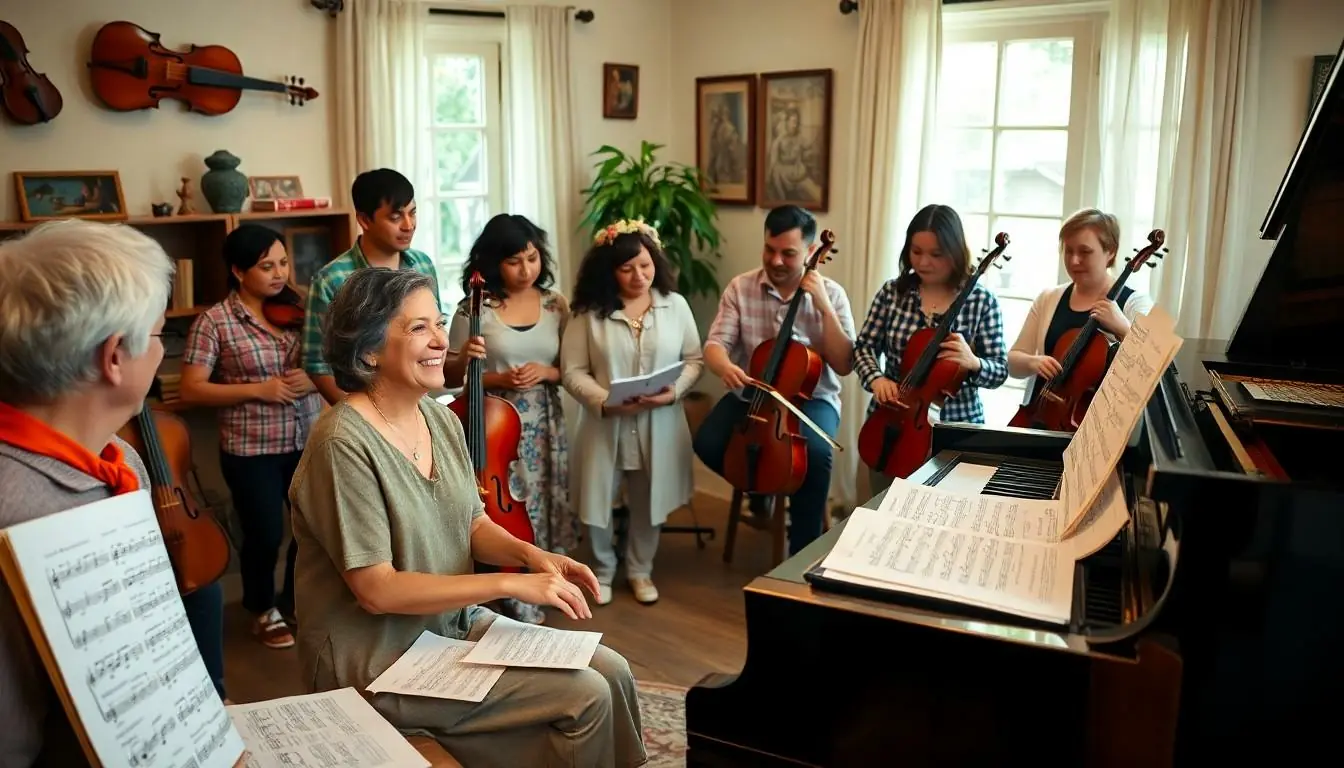Table of Contents
ToggleClassical music often seems like an exclusive club where only the elite are allowed in. But guess what? It’s time to break down those velvet ropes and invite everyone to the symphonic party! Whether you think Beethoven is a fancy cheese or you’ve never heard of Tchaikovsky outside of a holiday movie, this guide is your golden ticket to understanding and enjoying classical music without the snooze factor.
Overview of Classical Music
Classical music encompasses a wide range of styles and historical periods, creating a rich tapestry of sound that appeals to diverse audiences. Originating in the Western tradition, it spans several centuries, with significant developments from the medieval era through modern times. Major periods include the Baroque, Classical, Romantic, and Contemporary, each contributing unique characteristics and compositional techniques.
Notable composers such as Bach, Mozart, and Beethoven revolutionized music and created timeless works. They utilized various forms, including symphonies, sonatas, and operas, showcasing their individual styles and innovations. Each piece often conveys deep emotions and intricate narratives, enriching the listener’s experience.
Understanding classical music can enhance appreciation. Familiarity with instruments—like the violin, piano, and orchestra—provides insight into how composers arranged their scores. Different genres within classical music, such as chamber music and choral works, offer distinct listening experiences as well.
Engagement with classical music involves recognition of key elements like melody, harmony, and rhythm. Exploring pieces in their historical context reveals how cultural influences shaped the music. Interactive experiences, such as attending live concerts or participating in discussions, foster a deeper connection with the art form.
Ultimately, classical music is an accessible journey for everyone. By exploring its vast repertoire, listeners can discover personal favorites and cultivate a lifelong relationship with this timeless genre.
Key Components of Classical Music

Classical music consists of distinct elements that contribute to its rich complexity and appeal. Understanding these components aids listeners in appreciating this timeless genre.
Instruments and Their Roles
Instruments in classical music play unique roles, each contributing to the overall sound. Strings, such as violins and cellos, deliver warm melodies and harmonies. Woodwinds like flutes and clarinets add color and texture. Brass instruments, including trumpets and trombones, create powerful and bold statements. Percussion, encompassing drums and cymbals, provides rhythm and dynamics. Ensemble arrangements often feature varying instrument combinations, highlighting the individual qualities of each while fostering collaboration and interaction among players.
Musical Notation Explained
Musical notation serves as a written language for composers. It communicates precise instructions for performance. Staff lines indicate pitch, while notes specify duration and intensity. Symbols represent various dynamics, articulations, and expressions. Composers utilize these notations to convey their artistic intentions, ensuring performances remain faithful to their vision. Understanding this notation allows listeners to grasp the structure and flow of compositions, providing insights into the works’ emotional depth and complexity.
Major Classical Music Periods
Classical music has evolved through distinct periods, each bringing unique characteristics and influential composers. Understanding these major periods enhances appreciation for the genre.
Baroque Period
The Baroque period spans from 1600 to 1750. Composers like Johann Sebastian Bach and George Frideric Handel defined this era with complex polyphony. Ornamentation became a hallmark, with elaborate melodic lines captivating audiences. The use of contrast in dynamics created dramatic tension within compositions. Instrumentation also expanded, introducing the harpsichord and violin to prominence. Overall, this period laid a robust foundation for future musical developments, blending emotion with technical skill.
Classical Period
The Classical period, lasting from 1750 to 1820, emphasized clarity and balance. Composers such as Wolfgang Amadeus Mozart and Franz Joseph Haydn championed form, using structures like sonatas and symphonies. Melody gained prominence, often featuring memorable themes. Simplified harmonies emerged, allowing for greater accessibility. Orchestras grew in size, incorporating more strings and woodwinds. The music of this time invites listeners to experience elegance and refinement, highlighting the beauty of simplicity.
Romantic Period
From 1820 to 1900, the Romantic period shifted focus to personal expression. Composers like Ludwig van Beethoven and Johannes Brahms explored emotion and individualism. The emergence of programmatic music allowed composers to convey stories and ideas. Expansive melodies and rich harmonies dominated compositions, creating powerful emotional landscapes. Innovations in orchestration expanded possibilities, leading to more vibrant sounds. This period celebrates human experience, inviting listeners to connect deeply with the music.
Notable Composers to Know
Understanding key composers enriches the classical music experience. Familiarity with their contributions reveals the depth of this genre.
Johann Sebastian Bach
Bach, a German composer, significantly influenced Western music. His works include over 1,000 pieces, blending intricate counterpoint with deep emotion. Known for compositions like “Brandenburg Concertos” and “The Well-Tempered Clavier,” his mastery of harmony set standards for future generations. Bach’s use of sacred themes shaped the Baroque period’s music landscape. His unique ability to convey intricate melodies defined his legacy, making him essential in any classical music discourse.
Ludwig van Beethoven
Beethoven, a pivotal figure in classical and Romantic music, transformed musical expression. His compositional style is marked by innovative structures and emotional intensity. The “Symphonies” range from the famous “Ninth” with its choral finale to the powerful “Fifth,” showcasing Beethoven’s evolution as a composer. He also advanced piano sonatas, notably with the “Moonlight Sonata.” His influence remains profound, inspiring countless musicians and shaping the future of music.
Pyotr Ilyich Tchaikovsky
Tchaikovsky, a Russian composer, is celebrated for his ballets and symphonic poems. His works, including “Swan Lake” and “The Nutcracker,” meld vibrant melodies with rich orchestration. Known for his ability to evoke emotion, Tchaikovsky’s “Pathétique Symphony” exemplifies his deep expressionism. His unique incorporation of Russian folk themes distinguished his compositions. Tchaikovsky’s legacy continues to captivate audiences, underscoring his significance in classical music history.
Tips for Enjoying Classical Music
Explore various ways to appreciate classical music. Listening to different styles exposes listeners to rich emotional experiences. Attend live concerts for an immersive atmosphere that recordings can’t replicate. Familiarize yourself with different composers for a broader understanding of their unique sounds.
Engaging with the music enhances enjoyment. Read program notes to grasp context, including the history behind the pieces and composers. Utilize playlists featuring favorite works to ease into the genre. Listening to well-known pieces such as Beethoven’s “Symphony No. 9” or Mozart’s “Eine kleine Nachtmusik” provides accessible entry points.
Take time to analyze compositions. Focus on specific elements like dynamics and instrumentation that create emotional depth. Noticing varying tempos and styles can elevate the listening experience. Enjoying classical music becomes more rewarding when listeners understand the transition from one movement to another.
Consider incorporating classical music into daily routines. Background music during work or study sessions can enhance concentration. Some genres, like baroque, are particularly effective for promoting focus due to their structured nature.
Discuss music with others to enrich understanding. Joining community groups or online forums provides opportunities to share insights and recommendations. Engaging in conversations about favorite pieces helps deepen appreciation for the genre.
Lastly, maintain an open mind. Discovering classical music’s vast array of styles, from orchestral to chamber music, opens doors to new experiences. Embracing this versatility allows individuals to find personal favorites and develop a lasting appreciation for classical music.
Classical music offers a rich tapestry of sounds and emotions that anyone can enjoy. By breaking down barriers and misconceptions about the genre, it becomes clear that classical music is for everyone.
Exploring its various styles and understanding the contributions of influential composers can transform the listening experience. Engaging with the music—whether through live performances or personal exploration—opens up a world of appreciation and connection.
With an open mind and a willingness to learn, anyone can embark on a rewarding journey through the timeless realm of classical music.






